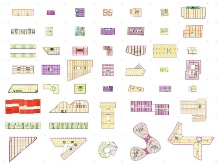Potentials and Limitations in Multi-storey Timber Building Design and Construction
Introduction
Since the early 2000s there has been a significant rise in multi-storey timber building construction worldwide enabled by advances in timber products and changes in construction regulations. It was brought on due to environmental challenges of decarbonization, urbanization and densification of cities at a time of significant and continued stagnation in the building industry and a productivity gap related to the low level of digitalization. Timber has potential to combat both of these issues. It has potential as a global carbon sink and is at the same time a highly digital material due to its high level of prefabricability, ease of processing, programming, and speed of construction. However, current wood building systems are defined by their modular nature. Even though engineered wood processes open up fabrication of modules of almost unlimited size and shape, the requirements of transportation and ease of on-site assembly greatly limit the complexity and scale of these systems and the resulting buildings. At the same time, recent developments in computational design methods, material sciences and fabrication processes open up new possibilities to overcome technical limitations in timber construction. Despite this, there is no clear understanding of how computational co-design may shape timber architecture and what opportunities and characteristics could be derived from these developments.
Aim, Research Question and Hypothesis
This research addresses the design of contemporary mass-timber multi-storey buildings from an architectural perspective. The aim is to identify potentials of computational co-design for multi-story timber buildings, specifically how co-design can contribute to spatially attractive and programmatically flexible multi-storey timber buildings. This challenge will be investigated by exploring co-design-derived building typologies and morphologies, related spatial organization and aesthetic characteristics, as specified by the following research question:
What are the constraints and what are the possibilities in contemporary timber architecture?
This is supplemented with the following hypotheses:
- Current timber building systems produce limited typologies and spatial variation;
- Current timber building systems rely heavily on concrete and steel for greater performance;
- There are still relatively few stakeholders overall pushing the developments towards greater design freedom in timber;
- The potentials of digitalization and computation in practice have not been fully tapped in timber construction;
- Co-design derived and computational design approaches offer great potentials for novel and flexible multi-storey timber architecture
Methodology
The questions and hypotheses will be investigated through:
- systematization of current approaches in timber construction,
- contextualization of developments in timber architecture and construction,
- and characterization of co-design-enabled potentials for design in architecture.
The design requirements for novel and flexible multi-storey timber design will be set at the start of the project. This will be followed by mapping possibilities and constraints of current approaches in serial and modular wood construction, and will consist of three surveys: What and How multi-storey timber buildings are constructed, and Who is constructing them.
The results of these studies will be synthesized and contextualized in the wider timber construction industry beyond multi-storey construction, specifically relating to developments in automation, digitalization, and computation. The focus will be Why multi-storey timber buildings are constructed in these ways.
Finally, the research will identify How could multi-storey timber buildings be designed and Which alternatives to current approaches might be possible. This will include a systematization of building typologies and related ordering systems and spatial organizations in direct feedback with the development of a novel multi-story timber building system within EXC 2120 – RP-3 project; a variable density, point-supported multi-directional timber slab system. Characterization of architectural aesthetics will be investigated through two design exploration case studies.
Expected Results and Contribution
The dissertation will provide a more comprehensive understanding of the potentials of integrative and computational approaches for multi-storey timber construction and architecture, as well as detailed survey analysis overview of current developments, potentials and shortcomings in mass-timber multi-storey construction. The research will show that:
- There is a lack of architectural and spatial variety in timber construction, spatial organization and situations are far less limited than in concrete or steel construction.
- Current approaches in serial and modular construction produce timber building systems which are mostly based on rigid grids, steel connections, and limited uni-directional spans.
- Innovators in timber construction are still mostly fabricators, and level of automation in practice determines the possible level of design variation.
- Resurgence of standardization of designs and buildings in construction; timber start ups operating on similar concepts to industrialized modular construction of 1960’s which can constrain design freedom in practice, result in spatial monotony and lack of spatial adaptability and may compromise future repurposing of timber buildings.
- A demonstration of design application of a flexible novel computational multi-storey timber building system showing computational approaches can lead to more adaptive, network based systems that enable individual, site-specific architecture fit for a longer lifespan and repurposing.
PROJECT TEAM
ICD Institute for Computational Design and Construction, University of Stuttgart
Hana Svatoš-Ražnjević, Prof. A. Menges
PROJECT FUNDING
Cluster of Excellence Integrative Computational Design and Construction for Architecture (IntCDC) (EXC 2120/1 RP 10)
RELATED PUBLICATIONS
- Svatoš-Ražnjević, H., Boeva, Y., Kropp, C., & Menges, A. (2025). Trajectories from standard to incremental and pioneering innovation in timber construction: multi-storey timber buildings in Germany, Austria, and Switzerland. Building Research & Information. https://doi.org/10.1080/09613218.2025.2482970
- Svatoš-Ražnjević, H., Krtschil, A., Orozco, L., Neubauer, G., Knippers, J., & Menges, A. (2023). Towards Design Flexibility and Freedom In Multi-Storey Timber Construction: Architectural Applications of a Novel, Adaptive Hollow Slab Building System. In K. A. Malo, A. Q. Nyrud, & K. Nore (Eds.), World Conference on Timber Engineering (WCTE 2023) (pp. 3905–3916). World Conference on Timber Engineering (WCTE 2023). https://doi.org/10.52202/069179-0508
- Orozco, L., Svatoš-Ražnjević, H., Wagner, H. J., Abdelaal, M., Amtsberg, F., Weiskopf, D., & Menges, A. (2023). Advanced Timber Construction Industry: A Quantitative Review of 646 Global Design and Construction Stakeholders. Buildings, 13, Article 9. https://doi.org/10.3390/buildings13092287
- Svatoš-Ražnjević, H., Orozco, L., & Menges, A. (2022). Advanced Timber Construction Industry : a Review of 350 Multi-Storey Timber Projects from 2000–2021. Buildings, 12, Article 4. https://doi.org/10.3390/buildings12040404
Contact Information

Hana Svatoš-Ražnjević
M.Sc.Research Associate


